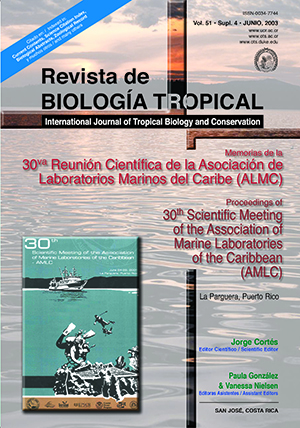Abstract
Two naturally occurring colonies of Millepora alcicornis were monitored during 1997 and 1998, both years in which this species bleached in the Mexican Caribbean. One colony (HL) was naturally exposed to a high light environment and another nearby colony (LL) was exposed to 5.9 times lower light levels due to shadowing by a pier. For 10 days in August 1997, seawater temperatures in the surrounding reef lagoon rose up to 1.5oC above the 6-year August average. The HL colony bleached to white during this period, whereas, the LL colony remained dark-brown colored. The HL colony recovered its normal dark-brown coloration (reversible bleaching) within several weeks, during which time the seawater temperatures returned to average. The following year, for 10 days, seawater temperatures rose up to 3°C above the 7-year August average and both colonies bleached to white and neither colony recovered (irreversible bleaching). Both colonies were rapidly overgrown by algae and hydroids and, as of June 2003, no recovery has taken place. Prior to the 1997 bleaching, experiments using solar radiation showed that the quantum yield of photosystem II charge separation of branches from HL and LL colonies were affected for several hours by exposure to ultraviolet radiation (UVR, 280 to 400 nm), but recovered by the same evening, suggesting that UVR does not have long-term effects on photochemistry in M. alcicornis. In situ effective quantum yield of photo-system II charge separation (ΔF/Fm´) measurements before the 1998 bleaching event indicate that both colonies were healthy in terms of the physiological status of their endosymbionts. During and after the 1998 bleaching event, both colonies showed a reduction in ΔF/Fm´ and consequently an increase in excitation pressure on photosystem II. The data suggest that temperature is not the only factor that causes bleaching and that solar radiation may play an impor-tant role in coral bleaching.References
Glynn, P. W. 1996. Coral reef bleaching: facts, hypotheses and implications. Global Change Biol. 2: 495-509.
Gorbunov, M.Y., Z.S. Kolber, M.P. Lesser & P.G. Falkowski. 2001. Photosynthesis and photoprotection in symbiotic corals. Limnol. Oceanogr. 46: 75-85.
Iglesias-Prieto, R., J.L. Matta, W.A. Robins & R.K. Trench. 1992. Photosynthetic response to elevated temperature in the symbiotic dinoflagellate Symbio-dinium microadriaticum in culture. Proc. Natl. Acad. Sci. USA 89: 10302-10305.
Jeffrey, S.W. & G.F. Humphrey. 1975. New spectrophoto-metric equations for determining chlorophylls a, b, c1 and c2 in higher plants, algae and natural phyto-plankton Biochem. Physiol. Pflanzen 167: 191-194.
Jones, R.J., O. Hoegh-Guldberg, A.W.D. Larkum & U. Schreiber. 1998. Temperature-induced bleaching of corals begins with impairment of the CO2 fixation mechanism in zooxanthellae. Plant Cell Environ. 21: 1219-1230.
Kolber, Z., J. Zehr & P. Falkowski. 1988. Effects of growth irradiance and nitrogen limitation on photo-synthetic energy conversion in Photosystem II. Plant Physiol. 88: 923-929.
Lesser, M. P. 1996. Exposure of symbiotic dinoflagellates to elevated temperatures and ultraviolet radiation causes oxidative stress and inhibits photosynthesis. Limnol. Oceanogr. 41: 271-283.
Maxwell, D.P., S. Falk & P.A. Huner. 1995. Photosystem II excitation pressure and development of resistance to photoinhibition. I. Light-harvesting complex II abundance and zeaxanthin content in Chlorella vulgaris. Plant Physiol. 105: 535-543.
Warner, M.E., W.K. Fitt & G.W. Schmidt. 1996. The effect of elevated temperature on the photosynthetic efficiency of zooxanthellae in hospite from four dif-ferent species of reef coral: A novel approach. Plant Cell Environ. 19: 291-299.
Warner, M.E., W.K. Fitt & G.W. Schmidt. 1999. Damage to photosystem II in symbiotic dinoflagellates: A de-terminant of coral bleaching. Proc. Natl. Acad. Sci. USA 96: 8007-8012.
##plugins.facebook.comentarios##

This work is licensed under a Creative Commons Attribution 4.0 International License.
Copyright (c) 2003 Revista de Biología Tropical


